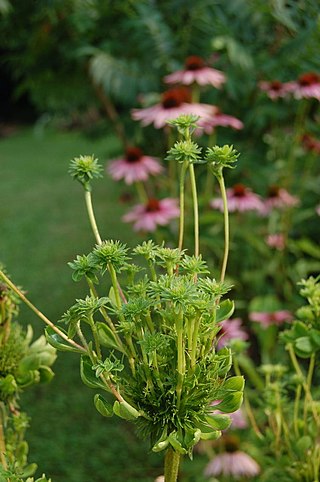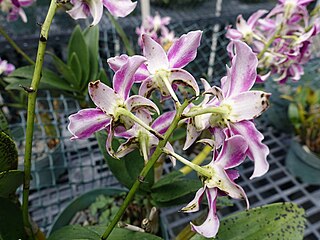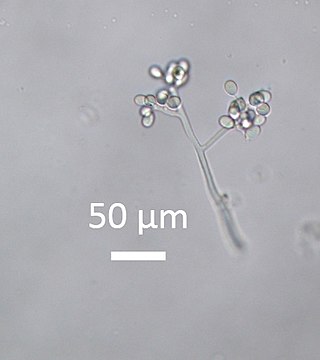
Nicotiana is a genus of herbaceous plants and shrubs in the family Solanaceae, that is indigenous to the Americas, Australia, Southwestern Africa and the South Pacific. Various Nicotiana species, commonly referred to as tobacco plants, are cultivated as ornamental garden plants. N. tabacum is grown worldwide for the cultivation of tobacco leaves used for manufacturing and producing tobacco products, including cigars, cigarillos, cigarettes, chewing tobacco, dipping tobacco, snuff, and snus.

Texas root rot is a disease that is fairly common in Mexico and the southwestern United States resulting in sudden wilt and death of affected plants, usually during the warmer months. It is caused by a soil-borne fungus named Phymatotrichopsis omnivora that attacks the roots of susceptible plants. It was first discovered in 1888 by Pammel and later named by Duggar in 1916.

Phytoplasmas are obligate intracellular parasites of plant phloem tissue and of the insect vectors that are involved in their plant-to-plant transmission. Phytoplasmas were discovered in 1967 by Japanese scientists who termed them mycoplasma-like organisms. Since their discovery, phytoplasmas have resisted all attempts at in vitro culture in any cell-free medium; routine cultivation in an artificial medium thus remains a major challenge. Phytoplasmas are characterized by the lack of a cell wall, a pleiomorphic or filamentous shape, a diameter normally less than 1 μm, and a very small genome.
Pharming, a portmanteau of farming and pharmaceutical, refers to the use of genetic engineering to insert genes that code for useful pharmaceuticals into host animals or plants that would otherwise not express those genes, thus creating a genetically modified organism (GMO). Pharming is also known as molecular farming, molecular pharming, or biopharming.
Pantoea stewartii is a species of plant pathogenic bacteria that causes Stewart's wilt of corn, as well as jackfruit-bronzing disease, bacterial leaf wilt of sugarcane, and leaf blight in rice. P. stewartii is a gram-negative bacterium in the Enterobacterales, a group that also includes Escherichia coli and several other human, animal, and plant pathogens. Most research on this bacterial pathogen to date has been done on strains infecting corn as the other diseases have been identified much more recently. Due to being relatively easy to work with in laboratory research, P. stewartii has been used to study a range of processes in bacterial physiology including quorum sensing, bacterial pigment production, endoglucanase enzymes, and siderophore-mediated iron acquisition.

Pseudomonas syringae is a rod-shaped, Gram-negative bacterium with polar flagella. As a plant pathogen, it can infect a wide range of species, and exists as over 50 different pathovars, all of which are available to researchers from international culture collections such as the NCPPB, ICMP, and others.
Pseudocercospora fuligena is a fungal plant pathogen infecting tomatoes. It is the cause of the fungal disease black leaf mold. The fungus was first described in the Philippines in 1938 and has since been reported in numerous countries throughout the tropics and subtropics. It was reported in the United States in 1974, initially in Florida, and has since been reported in non-tropical regions including Ohio and North Carolina.
Banana streak virus (BSV) is a name given to various plant viruses in the genus Badnavirus.

Odontoglossum ringspot virus (ORSV) is a plant pathogenic virus that belongs to the family Virgaviridae. It is one of the most common viruses affecting cultivated orchids, perhaps second only to the Cymbidium mosaic virus. It causes spots on leaves and colored streaks on flowers. If a plant is also infected with the Cymbidium mosaic virus, it can lead to a condition called blossom brown necrotic streak.
Potato virus X (PVX) is a plant pathogenic virus of the family Alphaflexiviridae and the order Tymovirales.
Turnip crinkle virus (TCV) is a plant pathogenic virus of the family Tombusviridae. It was first isolated from turnip.

Plasmopara is a genus of Oomycota. Plasmopara species are plant pathogens, causing downy mildew on carrot, parsley, parsnip, chervil, and impatiens.

enod40, also known as early nodulin 40, is a gene found in flowering plants. The gene has characteristics of both protein and Non-coding RNA genes. There is some evidence that the non-coding characteristics of this gene are more widely conserved than the protein coding sequences. In soyabeans enod40 was found to be expressed during early stages of formation of nitrogen-fixing root nodules that are associated with symbiotic soil rhizobial bacteria. The gene is also active in roots containing fungi forming phosphate-acquiring arbuscular mycorrhiza. An interaction with a novel RNA-binding protein MtRBP1 investigated in the development of Root nodule suggests ENOD40 has a function of cytoplasmic relocalization of nuclear proteins. In the study of non-legume plants, the over-expression of ENOD40 in transgenic Arabidopsis lines was observed a reduction of cell expansion.
In molecular biology mir-398 microRNA is a short RNA molecule. MicroRNAs function to regulate the expression levels of other genes by several mechanisms.

Medicago Inc. was a Canadian biotechnology company focused on the discovery, development, and commercialization of virus-like particles using plants as bioreactors to produce proteins, candidate vaccines, and medications. By using live plant leaves as hosts in the discovery and manufacturing process, the Medicago "Proficia" technology intended to create a rapid, high-yield system for its product candidates. Privately owned by a subsidiary of Mitsubishi Tanabe Pharma, Medicago and its product development programs were terminated by Mitsubishi in February 2023.

CoVLP was a COVID-19 vaccine developed by Medicago in Canada and GlaxoSmithKline (GSK). The product and Medicago, Inc. were owned by Mitsubishi who terminated the company and program in February 2023 due to high international market competition for COVID-19 vaccines.

Michael Maurice Goodin was a Jamaican-born plant virologist. He researched interactions between the virus and the host cell, focusing on rhabdoviruses that infect plants. He also studied emerging plant viruses, including economically significant viruses infecting coffee plants. He co-invented a widely used method of generating large amounts of expressed proteins in leaves infiltrated with Agrobacterium, and developed other techniques for plant molecular virology research. Goodin moved to the United States in around 1989 and was a professor at the University of Kentucky from 2017 until his death.

Cercosporin is a red toxin created by the fungal genus Cercospora.Cercospora act as pathogens on a variety of plants including corn, tobacco, soybean, and coffee. Cercosporin is a perylenequinone natural product that is photoactivated and uses reactive oxygen species (ROS) to damage cell components.
John M. McDowell is the J.B. Stroobants Professor of Biotechnology at Virginia Polytechnic Institute and State University. His major area of research is phytopathology and plant-pathogen interactions. He has used gene-sequencing technology to examine the genome of Phytophthora capsici and to develop strains of soybean plants that are better able to defend against pathogens.












